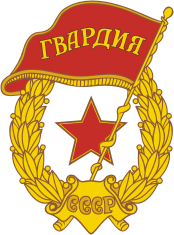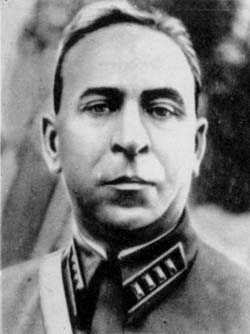Related Research Articles
A tank corps was a type of Soviet armoured formation used during World War II.

The 2nd Guards Tatsinskaya Tank Corps was a tank corps of the Soviet Union's Red Army that saw service during World War II on the Eastern Front of Europe. The unit's most notable moment was in the raid on Tatsinskaya during Operation Little Saturn in World War II. After the war, it continued to serve with the Soviet occupation forces in Central Europe. It was originally the 24th Tank Corps. The formation had approximately the same size and combat power as a Wehrmacht Panzer Division, and less than a British Armoured Division had during World War II.

The Central Group of Forces was a formation of the Soviet Armed Forces used to incorporate Soviet troops in Central Europe on two occasions: in Austria and Hungary from 1945 to 1955 and troops stationed in Czechoslovakia after the Prague Spring of 1968.

The 90th Guards Tank Division was a division of the Soviet Army, and then of the Russian Ground Forces.

The Soviet Airborne Forces or VDV was a separate troops branch of the Soviet Armed Forces. First formed before the Second World War, the force undertook two significant airborne operations and a number of smaller jumps during the war and for many years after 1945 was the largest airborne force in the world. The force was split after the dissolution of the Soviet Union, with the core becoming the Russian Airborne Forces, losing divisions to Belarus and Ukraine.

The 20th Guards Carpathian-Berlin Motor Rifle Division is a formation of the Russian Ground Forces, originally formed within the Soviet Red Army as the 3rd Mechanised Corps. The division was reformed in 2021 from the former 20th Guards Motor Rifle Brigade.
The 19th Army was a field army of the Soviet Union's Red Army, formed in 1941 and active during the Second World War. The army was formed three times, although only two of its formations saw combat.

The 22nd Mechanized Brigade is a formation of the Ukrainian Ground Forces. It traces its origins to the 66th Guards Rifle Division, originally a formation of the Red Army and later of the Soviet Ground Forces.
The 2nd Mechanised Corps was a formation in the Soviet Red Army during the Second World War.

The 28th Army was a field army of the Red Army and the Soviet Ground Forces, formed three times in 1941–42 and active during the postwar period for many years in the Belorussian Military District.

The Northwestern Operational Command (SZOK) is a command of the Belarus Ground Forces. It is headquartered at Borisov and is commanded by Major General Alexander Volfovich. The command includes a mechanized brigade and a mixed artillery brigade. It was formed in 2001 from the 65th Army Corps.
The 9th Mechanized Corps was a mechanized corps of the Soviet Red Army, formed twice. It was first formed in November 1940 and disbanded in September 1941 after suffering heavy losses. The corps was formed again in August 1943 at Tula. The second formation fought with the 3rd Guards Tank Army. It participated in the Battle of the Dnieper, the Battle of Kiev (1943), the Dnieper–Carpathian Offensive, the Zhitomir–Berdichev Offensive, the Lvov–Sandomierz Offensive. the Battle of Berlin and the Prague Offensive. During the war the corps received the honorifics "Kiev" and "Zhitomir" and was awarded the Order of the Red Banner, the Order of Suvorov 2nd class, and the Order of Kutuzov 2nd class.

The 11th Guards Mechanized Brigade is a unit of the Armed Forces of Belarus based in Slonim. The 11th Guards Brigade traces its history back to the 1942 formation of the 6th Tank Corps of the Soviet Army during World War II.
The 32nd Guards Tank Division was a tank formation of the Soviet Army/Soviet Ground Forces. Its predecessor, the 9th Guards Airborne Division, was a Red Army Airborne division of World War II. On 19 June 1945, it became the 116th Guards Rifle Division. In 1946, it became the 14th Guards Mechanized Division. In 1957, it became the 14th Guards Motorized Rifle Division. In 1982, it became the 32nd Guards Tank Division, which was disbanded in June 1989.

Alexey Grigoryevich Rodin was a Soviet Army colonel general and Hero of the Soviet Union.

Georgy Semyonovich Rodin was a Red Army lieutenant general. Rodin fought in World War I as a non-commissioned officer of the Imperial Russian Army. He joined the Red Army in 1918 and became an officer, fighting in the Russian Civil War. In 1938, he was transferred to the reserve but returned to active duty in 1939 and led a tank battalion in the Soviet invasion of Poland. Rodin led a tank regiment in the Winter War and became commander of a brigade in December 1940. The brigade became the 47th Tank Division in March 1941.
The 169th Rifle Division was formed as an infantry division of the Red Army beginning in late August 1939, as part of the pre-war Soviet military build-up. It saw service in the occupation force in western Ukraine in September. The German invasion found it still in Ukraine, fighting back to the Dniepr until it was nearly destroyed. The partly-rebuilt division fought again at Kharkov, then was pulled back into reserve and sent deep into the Caucasus where it fought south of Stalingrad throughout that battle. Following another major redeployment the division helped in the liberation of Oryol, and the following race to the Dniepr. In 1944 and 1945 it was in 1st and 2nd Belorussian Fronts, participating successfully in the offensives that liberated Belarus, Poland, and conquered eastern Germany. It ended the war on the Elbe River.
The 321st Rifle Division was formed in September 1941, as a standard Red Army rifle division, based on an existing division of militia. This formation had an extremely short career, coming under devastating attack in the north of the Crimea on the day of its redesignation and being officially disbanded just over a month later. A second division began forming in the Transbaikal in February 1942, and served in the defensive and offensive fighting around Stalingrad, eventually distinguishing itself sufficiently to be redesignated as the 82nd Guards Rifle Division. The world had not seen the last of the 321st, however, as a new division was formed from two existing rifle brigades in the spring of 1944, which gave very creditable service for the duration, completing its combat path in northeastern Germany, and serving into the postwar period.
The 68th Guards Rifle Division was reformed as an elite infantry division of the Red Army in February 1943, based on the 1st formation of the 96th Rifle Division, and served in that role until after the end of the Great Patriotic War. It originally served in the Stalingrad Group of Forces, mopping up in the ruins of that city after the Axis surrender there before eventually being assigned to the 4th Guards Army and moving north to the Kursk area in the Steppe Military District. It entered combat with its Army during the Belgorod-Kharkov Offensive in August and continued fighting toward the Dniepr River and Kiev during the autumn and early winter. From late September until early November it was involved in the fighting around the Bukrin bridgeheads which ultimately ended in a stalemate. The 68th Guards was part of 1st Ukrainian Front until September, 1944 but was subordinated to numerous army and corps commands during this period and won an honorific in western Ukraine during March; subsequently it was also awarded the Order of the Red Banner for its part in the liberation of Lvov. After being removed to the Reserve of the Supreme High Command for much-needed rebuilding its combat path shifted into the Balkans. While rebuilding its antitank battalion had its towed pieces replaced with self-propelled guns and at the beginning of November the entire division was temporarily motorized to take part in an unsuccessful attempt to seize the city of Budapest via a mechanized thrust. The 68th Guards spent the remainder of the war fighting in Hungary and Austria; its regiments would all receive recognition for their roles in the battles for Budapest. The division was finally assigned to the 30th Rifle Corps of 26th Army in January, 1945 and remained under these headquarters for the duration of the war. Despite a solid record of service the 68th Guards was disbanded within two years.
The 212th Rifle Division was formed as an infantry division of the Red Army after a motorized division of that same number was badly damaged and then redesignated about five weeks after the start of the German invasion of the Soviet Union.
References
- Holm, Michael (2015-01-01). "100th Guards Training Motorised Rifle Division".